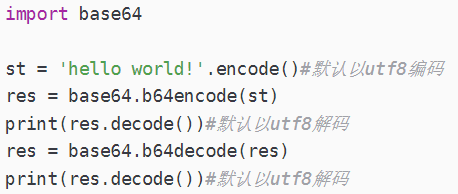论python常见内置模块
1.系统的内置模块
Sys
Hashlib
Hmac
Sys模块
Sys.argv 在python脚本传参使用
Sys.exit 系统退出
Sys.getdefaultencoding() 获取系统默认编码
Getfilesystemencoding() 获取文件编码
Getrecursionlimit() 获取系统默认递归的最大层数
Setrecursionlimit(num) 设置递归的最大层数
Getrefcount() 获取对象的引用计数的数量
Hashlib(不可逆加密):
加密,散列加密(hash加密)
加密是否可逆:
可逆加密(能还原回去)
根据加密和解密的密钥是否是同一个
对称加密
DES
非对称加密
RSA
不可逆加密
MD5、sha1256
Import hashlib
Dir(hashlib)


Base64模块
B64encode
B64decode
以"*encode"结尾的方法用于将二进制串转为base64编码格式的字符串,以“*decode”结尾的方法用于将base64格式的字符串重新转为二进制串

Time模块:
Asctime 获取系统当前时间
Ctime 获取系统当前时间
Time 获取当前的时间戳
Localtime 返回当前时间,以类似于元组的对象
T = time.localtime()
print("当前时间是%s-%s-%s %s:%s:%s" %(t.tm_year, t.tm_mon, t.tm_mday, t.tm_hour, t.tm_min, t.tm_sec))
time.strftime() # 将时间对象格式化成字符串
time.strftime("%Y-%m-%d %H:%M:%S", time.localtime())
time.strptime() # 时间字符串转换为时间对象
time.strptime('2019/09/18 21:02:44', "%Y/%m/%d %H:%M:%S")
Calendar 日历模块
import calendar
calendar.calendar() #返回指定的年的日历
- w = 每个日期之间的间隔字符数
- l = 每周所占用的行数
- c = 每个月之间的间隔字符数

calendar.month() #获取某年某月的月日历字符串
![]()
calendar.monthcalendar() 返回某年某月的月日历矩阵,每行代表一周
![]()
calendar.monthrange() 返回指定月份第一天(即1号)的星期日期,和本月的总天数

calendar.weekday() 返回指定日期所对应的星期日期

Datetim
datetime.datetime.now() # 获取系统当前时间
